|
|
|
Sort Order |
|
|
|
Items / Page
|
|
|
|
|
|
|
| Srl | Item |
| 1 |
ID:
167250
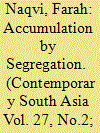

|
|
|
|
|
| Summary/Abstract |
This article is part of a Book Forum review of Ghazala Jamil’s book Accumulation by Segregation (2017). The Book Forum consists of individual commentaries on this text by four interested scholars, followed by a response by the author. The article may be read individually or alongside the other contributions to the Forum, which together constitute a comprehensive discussion of the themes and arguments in the book.
|
|
|
|
|
|
|
|
|
|
|
|
|
|
|
|
| 2 |
ID:
167254
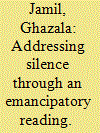

|
|
|
|
|
| Summary/Abstract |
This article is part of a Book Forum review of Ghazala Jamil’s book Accumulation by Segregation (2017). The Book Forum consists of individual commentaries on this text by four interested scholars, followed by a response by the author. The article may be read individually or alongside the other contributions to the Forum, which together constitute a comprehensive discussion of the themes and arguments in the book.
|
|
|
|
|
|
|
|
|
|
|
|
|
|
|
|
| 3 |
ID:
155747
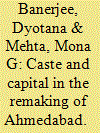

|
|
|
|
|
| Summary/Abstract |
The city has been eulogized as a liberating space of anonymity where identities of caste and creed dissolve before the might of economic capital. This paper examines how the role of caste is both masked and intensified in the formation of new neighbourhoods in the backdrop of city-remaking projects. Our ethnographic study of Dalit-dominated neighbourhoods in Ahmedabad shows that the emergence of a middle-class neighbourhood in Ahmedabad’s periphery must be seen as a ‘post-liberalization Dalit ghetto’ that is distinct from the pre-liberalization Dalit neighbourhoods in the industrial centre of the city. The new Dalit middle-class neighbourhood of Chandkheda is a result of greater economic mobility among Dalits which continues to be marked by the three exclusionary mechanisms: ‘moving up’ and into segregation; caste vigilantism; and protean forms of intra-Dalit exclusion. The collusion of caste and capital produces unexpected forms of space politics that tend to enhance rather than dissolve distinctions based on micro-caste identities in middle-class residential spaces, all the while hiding new forms of exclusion behind the rhetoric of secularized urban development.
|
|
|
|
|
|
|
|
|
|
|
|
|
|
|
|
| 4 |
ID:
120631
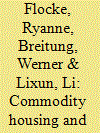

|
|
|
|
|
| Publication |
2013.
|
| Summary/Abstract |
Commodity housing has become a major engine of urban restructuring and social change in China. It is alleged to aid growing residential segregation and urban fragmentation. In this context, housing price is viewed as an important sorting mechanism. This article investigates this claim by looking at Guangzhou's housing market and analysing data of 797 commercial housing estates. It analyses the development of commodity housing and the trends of housing prices in the city and maps the locational patterns of high, middle, or low housing affordability within this sector.
|
|
|
|
|
|
|
|
|
|
|
|
|
|
|
|
| 5 |
ID:
167253
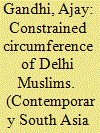

|
|
|
|
|
| Summary/Abstract |
This article is part of a Book Forum review of Ghazala Jamil’s book Accumulation by Segregation (2017). The Book Forum consists of individual commentaries on this text by four interested scholars, followed by a response by the author. The article may be read individually or alongside the other contributions to the Forum, which together constitute a comprehensive discussion of the themes and arguments in the book.
|
|
|
|
|
|
|
|
|
|
|
|
|
|
|
|
| 6 |
ID:
190344
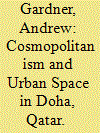

|
|
|
|
|
| Summary/Abstract |
This essay commences with an ethnographic sojourn through the Industrial Area, a peripheral zone of the urban landscape in Doha, Qatar that is densely inhabited by low wage migrant laborers. In this segregated urban enclave, I ascertain the openness to alterity and the interactions with difference that connect their experiences to the conceptual legacy of cosmopolitanism. Via a discussion of the segregated experiences of transnational migrants in Doha’s urban landscape, I then stake out a speculative argument for the connection between that segregation and the resulting cosmopolitan conditions. Together, these two assertions explore manifestations of cosmopolitan urbanism in non-Western and non-democratic cities. In the conclusion to this essay, I suggest that we might usefully disentangle our assessment of these cosmopolitan conditions from our sustained critiques of the global landscape of inequality, and turn my attention briefly to the western ethnocentricities that suffuse the analytic lens by which we gauge cosmopolitanism and the city.
|
|
|
|
|
|
|
|
|
|
|
|
|
|
|
|
| 7 |
ID:
143322
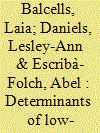

|
|
|
|
|
| Summary/Abstract |
What accounts for low-intensity intergroup violence? This article explores the determinants of low-intensity sectarian violence in Northern Ireland, which has marked the post-1998 peace agreement period. Low-intensity violence comprises a variety of events from riots to attacks against other civilians as well as against homes and symbolic buildings such as churches. We argue that this violence is more likely and prevalent in interface areas where similarly sized rival communities are geographically in contact with each other. Parity and contact spur intergroup competition and threat perception, and they increase the viability of violence. We use original cross-sectional time-series violence data for the 2005–12 period at a disaggregated subnational level, the ward, and a wide variety of social and economic indicators to test our hypotheses. In particular, we assess the impact of within-ward ethnic composition, on the one hand, and the ethnic composition of neighboring wards, on the other. We find that the number of intergroup violent events peaks in wards where there is parity between groups, and in predominantly Catholic (Protestant) wards that border predominantly Protestant (Catholic) wards. The article makes two main contributions: it shows that micro-level dynamics of violence can expand beyond local territorial units, and it suggests that ethnic segregation is unlikely to prevent intergroup violence.
|
|
|
|
|
|
|
|
|
|
|
|
|
|
|
|
| 8 |
ID:
040006
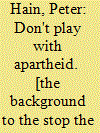

|
|
|
|
|
| Publication |
London, George Allen and Unwin Ltd., 1971.
|
| Description |
231p.Hbk
|
| Standard Number |
0043010318
|
|
|
|
|
|
|
|
|
|
|
|
Copies: C:1/I:0,R:0,Q:0
Circulation
| Accession# | Call# | Current Location | Status | Policy | Location |
| 010340 | 796.0968/HAI 010340 | Main | On Shelf | General | |
|
|
|
|
| 9 |
ID:
153012
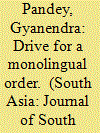

|
|
|
|
|
| Summary/Abstract |
This paper explores the changing contours of politics and democracy in our times by examining the ways in which populations and privileges are increasingly being distributed in cities and countries across the globe. In the light of these changing demographic and social conditions, it asks what are the appropriate terms for analysis of such population groups and their political aspirations, and suggests that we are working with outmoded analytical frames, concepts and languages that belong to another time. It goes on to a brief examination of the kinds of fault-lines that remain and that allow for a range of political initiatives and possibilities.
|
|
|
|
|
|
|
|
|
|
|
|
|
|
|
|
| 10 |
ID:
167251
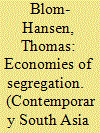

|
|
|
|
|
| Summary/Abstract |
This article is part of a Book Forum review of Ghazala Jamil's book Accumulation by Segregation (2017). The Book Forum consists of individual commentaries on this text by four interested scholars, followed by a response by the author. The article may be read individually or alongside the other contributions to the Forum, which together constitute a comprehensive discussion of the themes and arguments in the book.
|
|
|
|
|
|
|
|
|
|
|
|
|
|
|
|
| 11 |
ID:
160624
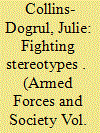

|
|
|
|
|
| Summary/Abstract |
This study examines reader responses to opinion editorials about women in combat and contributes to the literature on women in the military by explaining how contests over sex–gender essentialism and diversity underlie public debates about individual rights and military effectiveness. Comments in favor of women’s ground combat exclusion use a logic of averages to promote essentialist thinking about men and women. They categorize women as inferior soldiers and argue that desegregation puts individual soldiers and the nation at risk. Conversely, comments in favor of integration advance a view of sex–gender diversity that places men and women along a continuum with overlapping qualities, suggesting further that giving exceptional women the freedom to serve in ground combat will advance both equality and military readiness. We argue that public commentary about women in combat concerns more than the military, underlying this discourse are distinct conceptions and expectations of men and women.
|
|
|
|
|
|
|
|
|
|
|
|
|
|
|
|
| 12 |
ID:
134335
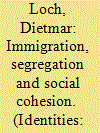

|
|
|
|
|
| Summary/Abstract |
In this article, we analyse immigrant integration against the background of German society’s social cohesion. First, we examine the integration process and policies with regard to the integration of first-generation labour migrants into the German ‘national society’ since the 1960s. Even though these ‘guest workers’ were confronted to ethnic and political exclusion owing to the so-called German integration model, they experienced socio-economic integration and, at the local level, some form of political participation. Secondly, we analyse the policies and the integration process of immigrant youth, specifically those of Turkish descent, into contemporary German society, the social cohesion of which is impeded by social exclusion and urban segregation. Our hypothesis is that – in spite of a long-standing refusal to recognise itself as an immigration country – Germany has to some extent incorporated its migrants and achieved an integration consensus, while paradoxically, national integration models in several other Western European countries are currently going through a deep crisis.
|
|
|
|
|
|
|
|
|
|
|
|
|
|
|
|
| 13 |
ID:
134331
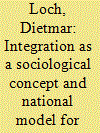

|
|
|
|
|
| Summary/Abstract |
This article introduces the special issue on the contemporary validity of national models of immigrant integration in Europe. From a historical perspective, we address integration as a sociological concept for the social cohesion of European societies and for the integration of their immigrants; subsequently, we discuss the current ‘crisis’ facing both. We then outline seven country studies in order to compare the differences and similarities of their integration models. Although the importance of national integration has decreased with urban segregation, cultural pluralisation, European integration and globalisation for citizens and immigrants, most of the contributions in this issue show that national models of immigrant integration have not completely failed.
|
|
|
|
|
|
|
|
|
|
|
|
|
|
|
|
| 14 |
ID:
006382
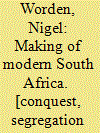

|
|
|
|
|
| Edition |
2nd ed.
|
| Publication |
Oxford, Blackwell, 1995.
|
| Description |
xvi, 171p.: mapspbk
|
| Series |
Historical Association Studies
|
| Standard Number |
0631198822
|
|
|
|
|
|
|
|
|
|
|
|
Copies: C:1/I:0,R:0,Q:0
Circulation
| Accession# | Call# | Current Location | Status | Policy | Location |
| 038038 | 968/WOR 038038 | Main | On Shelf | General | |
|
|
|
|
| 15 |
ID:
185592
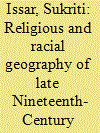

|
|
|
|
|
| Summary/Abstract |
The spatial separation of European colonialists and the local population was long seen as the defining feature of colonial cities. In recent years, the literature has moved toward a more ambivalent and contingent view of this spatial separation. This paper attempts to look beyond imagining the colonial city in terms of stark dualities or revisionist ambivalences, addressing both religious and racial separation. The paper analyses the street-level religious and racial geography of late nineteenth-century Bombay, using data from the 1881 Census. Results suggest moderate to high levels of racial and religious segregation in nineteenth-century Bombay at the street level, varying across groups, coupled with the existence of enclaves, and expressions of preference for segregation in diverse domains. The paper concludes that religion and race were meaningful social categories inscribed in urban space.
|
|
|
|
|
|
|
|
|
|
|
|
|
|
|
|
| 16 |
ID:
126170
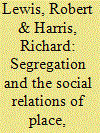

|
|
|
|
|
| Publication |
2013.
|
| Summary/Abstract |
For many, a defining feature of the colonial Indian city is the high rate of segregation of its European and Indians residents. Building on recent work that explores the messy realities of social and spatial relations, this paper argues that the social geographies of the colonial city were built on the social relations of place-the network of social relations that are bound up with a particular material setting. The result was that social spaces were centred on overlapping geographic patterns, intense negotiations over space, and heterogeneous lived-in spaces. In this paper, these points are examined through the case of Bombay's Modern Town at the turn of the twentieth century. Modern Town was supposedly the home of the city's European population and it stood in sharp contrast to the city's Native Town. However, Modern Town did not conform to the spatial topographies described by most writers. While formal residential segregation existed, social and economic articulation and interaction ensured that the district's social spaces were meshed in differentiated and complex ways.
|
|
|
|
|
|
|
|
|
|
|
|
|
|
|
|
| 17 |
ID:
146959
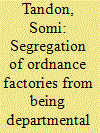

|
|
|
| 18 |
ID:
147317
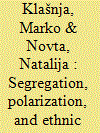

|
|
|
|
|
| Summary/Abstract |
An index of ethnic segregation conveys the extent of spatial mixing of ethnic groups, whereas an index of ethnic polarization and similar diversity measures show the overall balance between the groups. We present a game-theoretic model of conflict in which local success of one ethnic group encourages attacks by its co-ethnics in neighboring areas. Conditional on conflict breaking out, we find that for highly ethnically polarized societies, increasing ethnic segregation decreases the incidence and intensity of conflict. In contrast, in societies with low ethnic polarization, increasing segregation increases conflict. This is because segregation and polarization jointly determine the spread of conflict, an important channel that has been neglected previously. We find strong empirical support for model predictions in two very different conflicts: Hindu–Muslim riots in the 1980s and 1990s in India and the Bosnian Civil War from 1992 to 1995.
|
|
|
|
|
|
|
|
|
|
|
|
|
|
|
|
| 19 |
ID:
101857
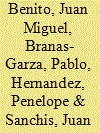

|
|
|
|
|
| Publication |
2011.
|
| Summary/Abstract |
This article shows the results of experiments where subjects play the Schelling's spatial proximity model. Two types of experiments are conducted: one in which choices are made sequentially and a variation of the first where the decision making is simultaneous. The results of the sequential experiments are identical to Schelling's prediction: subjects finish in a segregated equilibrium. Likewise, in the variant of the simultaneous decision experiment, the same result is reached: segregation. Subjects' heterogeneity generates a series of focal points in the first round. To locate themselves, subjects use these focal points immediately, and as a result, the segregation takes place again. Furthermore, simultaneous experiments with commuting costs allow us to conclude that introducing positive moving costs does not affect segregation.
|
|
|
|
|
|
|
|
|
|
|
|
|
|
|
|
| 20 |
ID:
167252
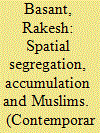

|
|
|
|
|
| Summary/Abstract |
This article is part of a Book Forum review of Ghazala Jamil’s book Accumulation by Segregation (2017). The Book Forum consists of individual commentaries on this text by four interested scholars, followed by a response by the author. The article may be read individually or alongside the other contributions to the Forum, which together constitute a comprehensive discussion of the themes and arguments in the book.
|
|
|
|
|
|
|
|
|
|
|
|
|
|
|
|
|
|
|
|
|